Contents
Often in the recipes of folk remedies and culinary dishes there are names of spices such as cumin and thyme. However, not everyone understands the difference between them, and confusion arises. Indeed, the names of these plants are consonant, but they differ not only in appearance, but also in taste and aromatic properties. Therefore, to avoid mistakes, you need to find out the difference between them.
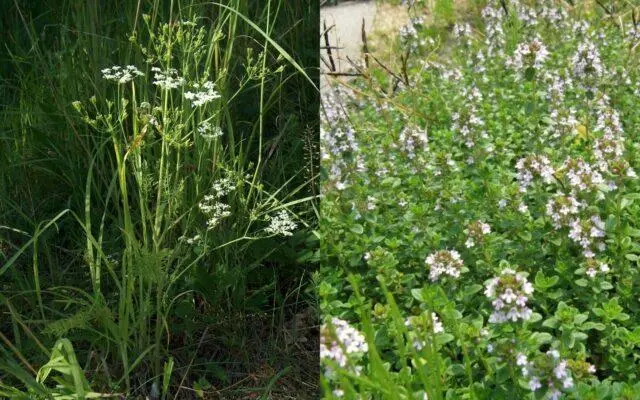
Cumin and thyme are visually impossible to confuse
Cumin and thyme: are they the same or not
Cumin and thyme are two different cultures. The first belongs to the Umbrella family. Close relatives of cumin are dill, celery, anise, fennel. The plant can be one- or two-year-old, depending on the variety. Cumin seeds are of value, rich in essential oils, which are widely used in various fields.
Thyme is a member of the Lamiaceae family. Its close relatives are basil, mint, lemon balm, lavender, oregano, rosemary. Thyme is a perennial crop. Young shoots of the plant are widely used, which are recommended to be cut during the flowering period. It is at this time that they contain the maximum amount of useful components.
What is the difference between cumin and thyme
To understand how these cultures differ from each other, it is necessary to consider the features of their appearance, taste, scope, cultivation. You should also pay attention to the places of growth.
Appearance
Cumin is a herbaceous plant, the height of which, depending on the species, can reach 0,3-1,5 m. It forms straight-growing single smooth stems, hollow inside. In the upper part of the plant, the shoots branch slightly.
The root of cumin is fleshy, spindle-shaped. The leaves are twice or thrice pinnatisected, with acutely linear lobes. The length of the plates is 6-20 cm, and the width is 20-10 cm. Cumin flowers are small, white or pink, collected in apical umbellate inflorescences. Their diameter is 4–8 cm. When ripe, it turns brown.
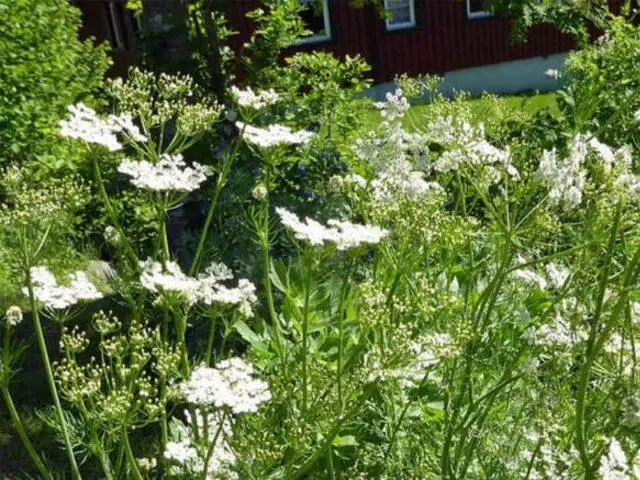
The cumin plant is similar in appearance to dill.
Thyme is a decumbent perennial shrub that forms tufts 15-20 cm high. Its shoots are thin, creeping type, easily rooted when in contact with the ground. Therefore, under favorable conditions, thyme forms a thick, lush carpet on the surface of the soil. The leaves of the plant are small, oval-oblong, hard. Thyme also has high decorative properties. This shrub blooms throughout the summer. Therefore, this culture is also used in landscape design. The color of thyme flowers can be pink, purple, purple, white. The buds are small, collected in loose spherical apical inflorescences. Thyme fruits are similar to small elliptical nuts no larger than 0,6 cm in size.
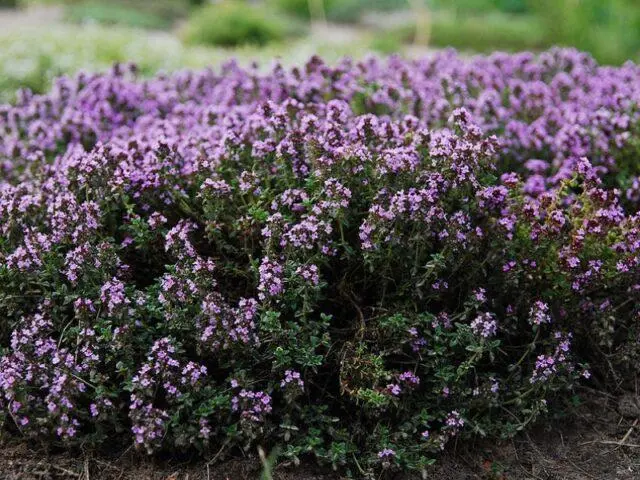
Thyme shoots become woody at the base as they mature.
Flavour and Fragrance
Thyme is distinguished by a pleasant rich aroma of spicy herbs. The smell may vary depending on the type of plant. Especially popular are varieties whose shoots and leaves have a pronounced lemon aroma. The taste of thyme is medium-sharp, slightly bitter, spicy. This plant is ideally combined with other fragrant herbs.
Cumin has a more tart taste, which combines sweetness and bitterness at the same time. The smell of the fruits of this plant resembles nutmeg and black walnut. The taste and aroma of this spice is revealed quickly when heated. Therefore, it is recommended to add it to hot dishes at the end of cooking.
Places of growth
Thyme is found in temperate climates. In its natural habitat, it grows in the steppe zones. This perennial is distributed from the Scandinavian countries to the Mediterranean and from the British Isles to Eastern Siberia. Thyme prefers sandy loamy soils and does not tolerate stagnant moisture. The semi-shrub can also be found on rocks, rocky slopes, well-lit forest edges.

Thyme grows even on depleted soils
The steppes of the Caucasus and Crimea are considered the birthplace of cumin. From where he came to the Mediterranean with spice merchants, to the Balkan Island, the Middle East, as well as to Asia Minor, North Africa. Currently, cumin is cultivated by many European countries that send fruits and oil for export. For own consumption, the plant is grown in Ukraine, Our Country, the Baltic countries, Scandinavia.
Cumin grows in gardens, forest-steppe, kitchen gardens, meadows, forest edges. The culture is undemanding to the composition of the soil, therefore it can grow even on saline soils.
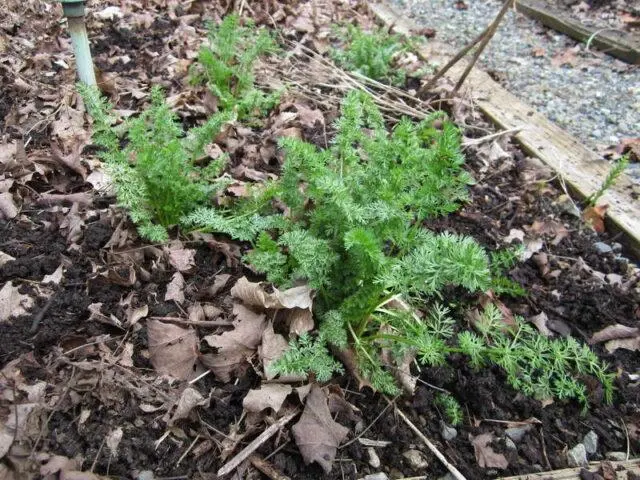
Cumin prefers a loose, moderately moist substrate.
Application
Cumin and thyme have a wide range of uses. Plants are used in cooking and medicine.
Cumin is added to bakery products, sausages, cheeses, fish. And also this spice is used in cooking, alcoholic beverage and confectionery production. At home, cumin is used for pickling cabbage, cucumbers, and making kvass. It is also added to soups, lamb, sauces. For medicinal purposes, dried fruits and essential oil of the plant are used.
Thyme is added to meat, chicken, vegetable dishes, broths, sauces, mushrooms, smoked meats, cheeses. This spice is also used in medicine.
Cultivation
Agrotechnics of cumin is not particularly difficult even for beginner gardeners. Planting seeds can be carried out in open ground in spring or late autumn. The plant develops well on sandy and loamy soils with rich organic matter. At the initial stage, it requires regular weeding and watering as needed.
Throughout the entire growing season, cumin should be fertilized twice, using phosphorus-potassium mineral mixtures. The fruits ripen in July. They are collected when half of the umbrellas on the plant turn brown.
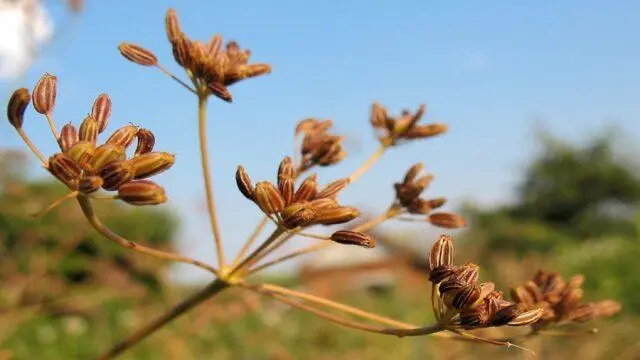
Cumin fruits do not ripen at the same time
When growing thyme, difficulties arise at an early stage in the development of seedlings. Therefore, it is recommended to sow this culture in seedlings. For thyme, you need to choose a well-lit area. It is important that the acidity level of the soil is low or neutral.
You can plant seedlings in a permanent place in the spring, when the earth warms up enough. Thyme does not need frequent watering. It tolerates drought well and can die if moisture stagnates in the soil. At the initial stage of planting, you need to weed and loosen the soil at the base of the plants. It is necessary to fertilize the shrub twice: in the spring – with organic matter, in the summer – with phosphorus-potassium mixtures.
What is healthier: cumin or thyme
Both plants have healing properties, but they are used to treat different diseases. Therefore, it is difficult to say which of these cultures is more useful.
Thyme-based preparations are prescribed for:
- bronchial asthma;
- colds;
- whooping cough;
- coughing;
- angina;
- laryngitis;
- gastrointestinal disorders.
In folk medicine, perennial is used to treat dermatitis, prostate adenoma, inflammation of the oral cavity, toothache and headache, painful menstruation, rheumatism.
Cumin helps:
- increase the outflow of bile;
- relieve intestinal spasms;
- normalize the process of digestion;
- improve lactation;
- with flatulence, atony.
In folk medicine, this plant is used as a laxative, as well as for the treatment of bronchitis, headaches, insomnia, and pneumonia.
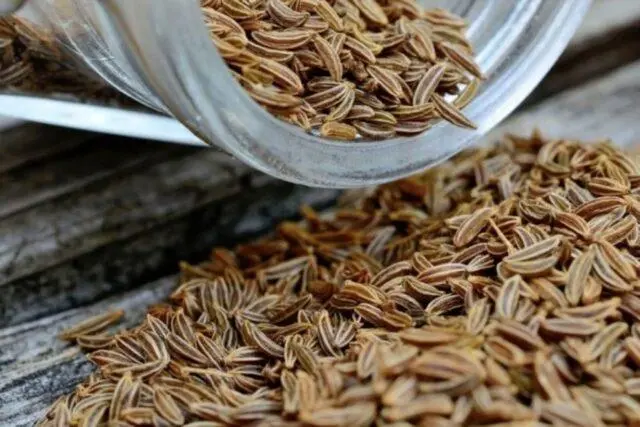
Cumin is part of many choleretic fees
Similarities of herbs
Both plants are excellent honey plants. Also, cumin and thyme are classified as undemanding crops, so even a novice gardener can handle their cultivation. The similarity lies in the fact that both cultures are widely used in cooking and have healing properties. Otherwise, they are completely different.
Conclusion
Cumin and thyme are spicy plants that are very much in demand. But when choosing a seasoning, you need to focus not only on the name, but also on the features of its use. After all, cumin and thyme are suitable for different dishes. In this case, the first is better to use in crushed form, and the fruits of the second are not recommended to be ground, since in this case they quickly lose their taste and aroma.









